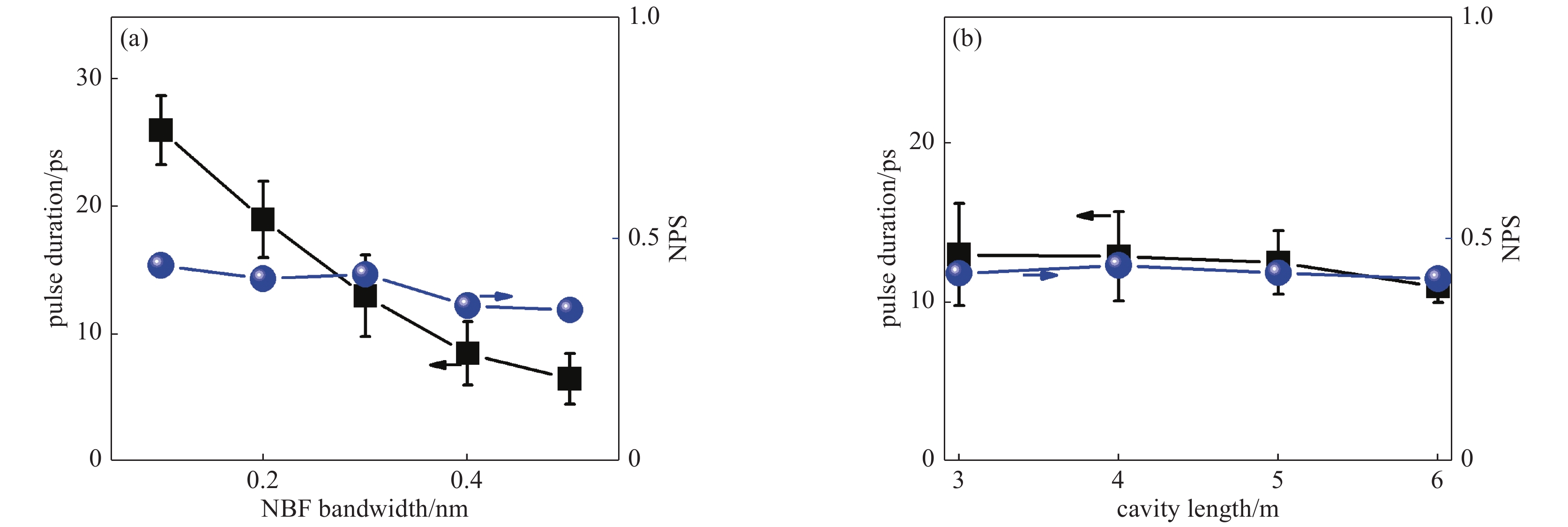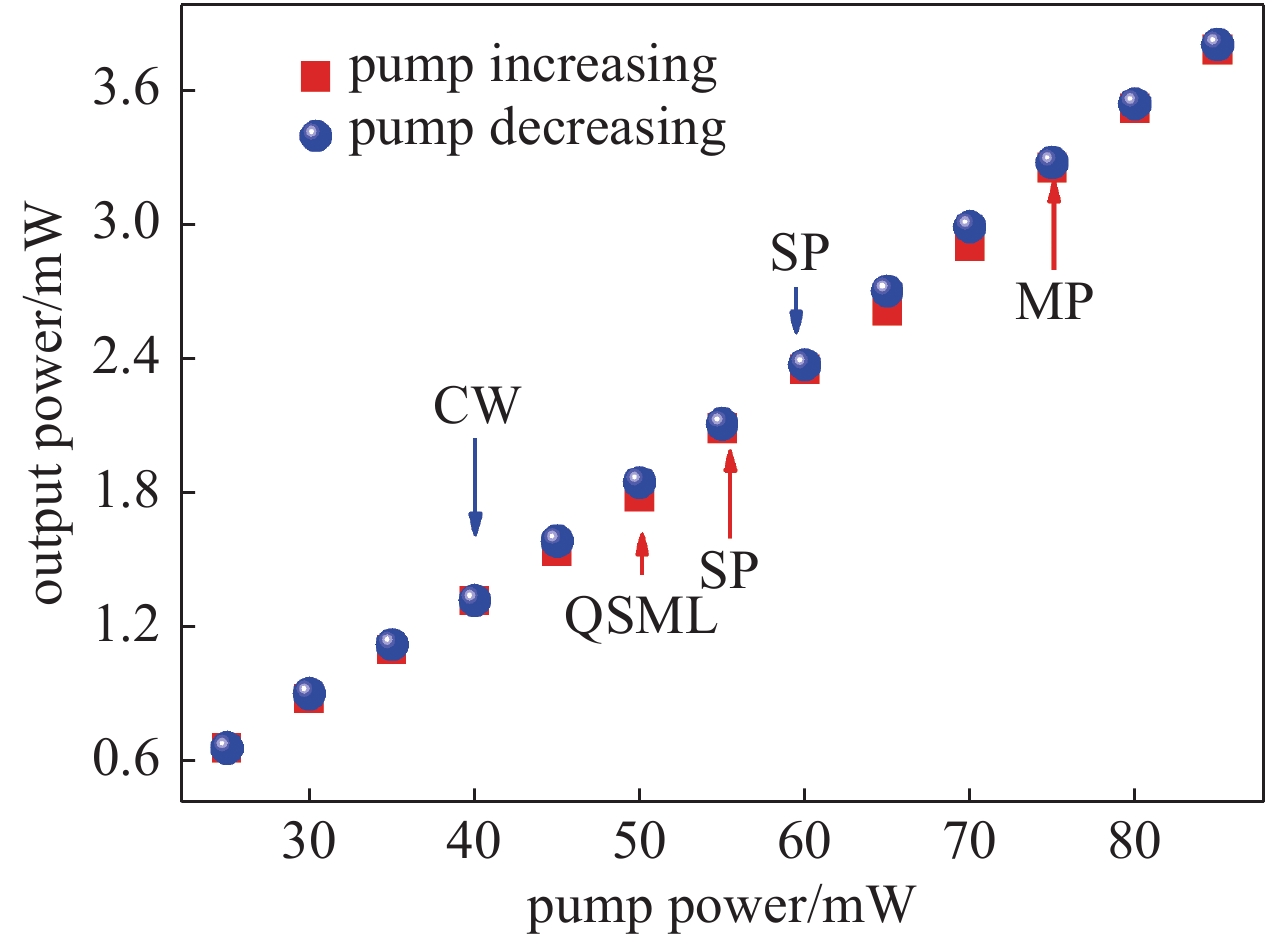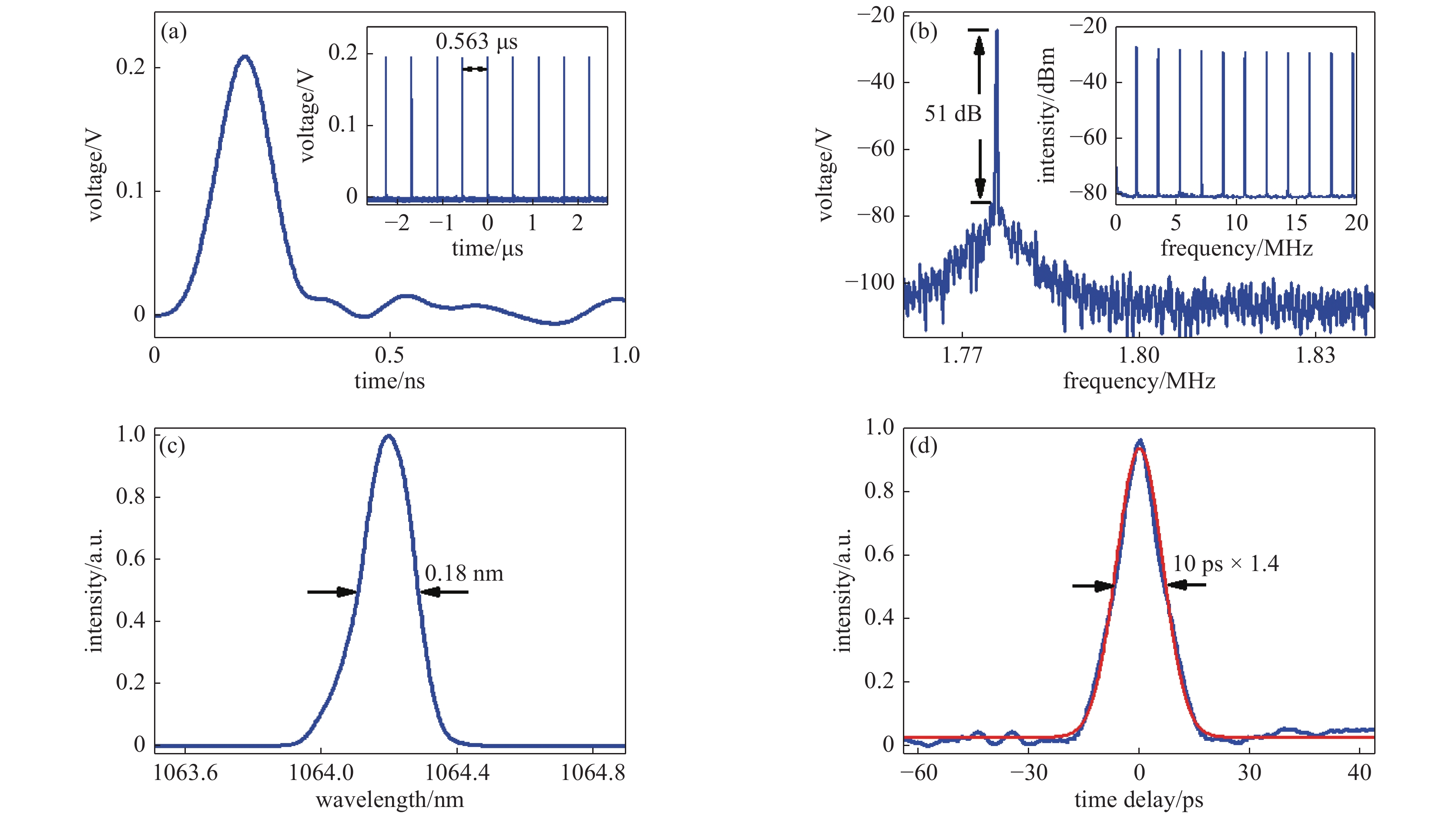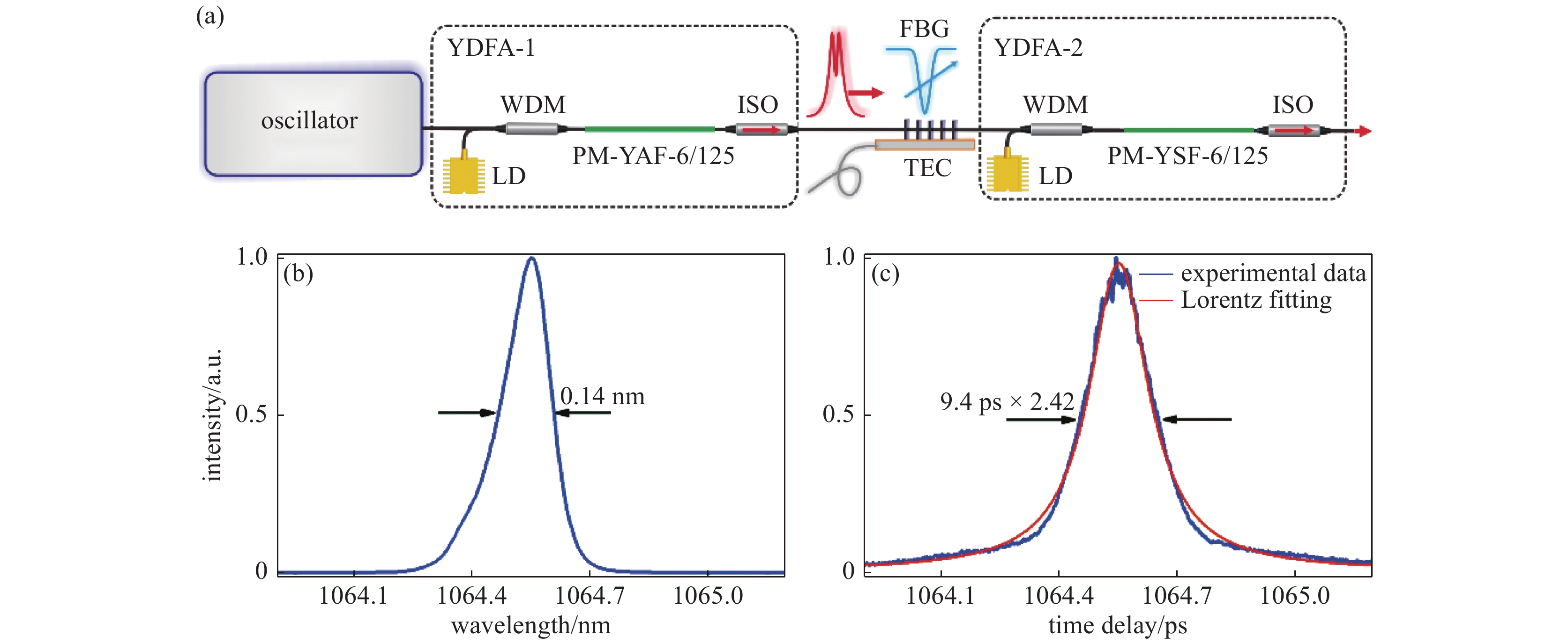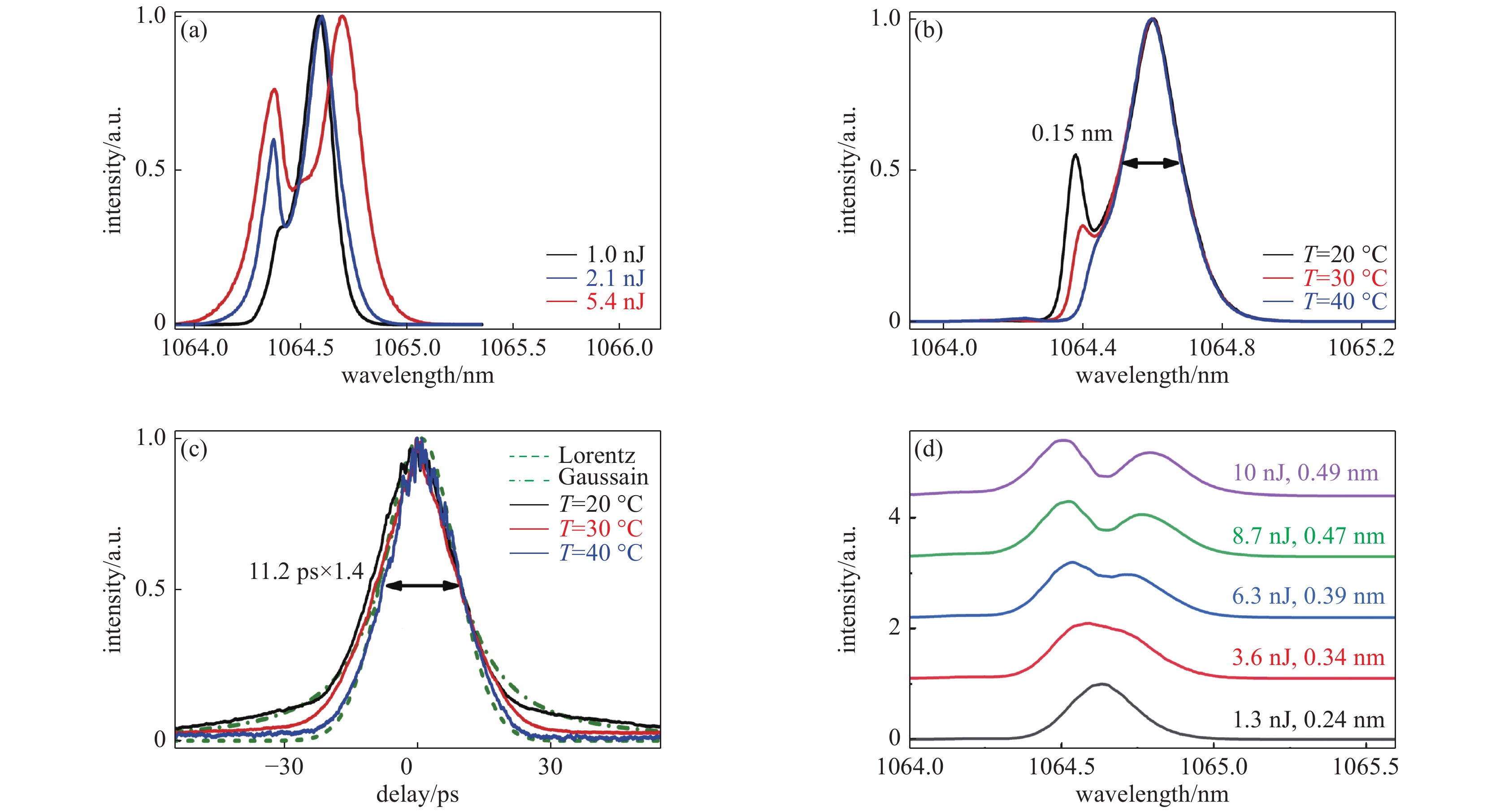Two key frontier issues on picosecond pulses generated by mode-locked fiber lasers
-
摘要: 窄带耗散孤子锁模光纤激光器可以产生接近变换限制的皮秒脉冲,但受非线性相移的限制,输出脉冲重复频率不能通过增加腔长来降低,脉冲能量仅在0.1 nJ以下,严重制约着这类皮秒脉冲的实际应用。提出一种通过耦合器抽取腔内脉冲能量、抑制腔内非线性相移积累,进而允许增加腔长来降低窄带耗散孤子皮秒光纤激光脉冲重复频率的方法。运用该方法,成功地将激光器重复频率由35.2 MHz降低到了1.77 MHz,且脉冲时频特性保持不变。提出了一种基于级间FBG陷波滤波的抑制皮秒脉冲光纤放大中光谱展宽的方法。通过简单地使用级间陷波滤波器,既可窄化第一级光纤放大器后的输出脉冲谱宽,允许采用第二级光纤放大器进一步提升脉冲能量,而且,还可将脉冲重塑为近高斯形,利用高斯脉冲光谱展宽斜率小的特点,允许第二级光纤放大器将脉冲能量提升得更高。利用该方法,在RMS(均方值)谱宽保持0.4 nm以内的前提下,10 ps脉冲经标准单模光纤放大器后,能量可由0.2 nJ可提升到10 nJ以上。Abstract: Narrowband dissipative soliton mode-locked fiber lasers can produce transform-limited picosecond pulses. Unfortunately, due to the limitation of allowable nonlinear phase shift for the intracavity pulse, the repetition rate of the pulses generated by such lasers cannot be reduced by increasing the cavity length; the pulse energy is only below 0.1 nJ. These seriously restrict the practical application of such picosecond pulsed fiber lasers. In this paper, we propose a method that allows the cavity length to be increased to reduce the repetition rate of the narrowband dissipative soliton picosecond fiber laser pulses by extracting the pulse energy out of the cavity with a coupler to suppress the accumulation of nonlinear phase shift of the intracavity pulses. Using this method, the laser repetition rate was successfully reduced from 35.2 MHz to 1.77 MHz, and the pulse time-frequency characteristics remained unchanged. We also propose a method to suppress spectral broadening in picosecond pulse fiber amplification based on inter-stage FBG notch filtering. By simply using the inter-stage notch filter, the output pulse spectrum width after the first-stage fiber amplifier can be narrowed, allowing the second-stage fiber amplifier to further increase the pulse energy, and also, the pulse can be reshaped to be nearly Gaussian-shaped, allowing the second-stage fiber amplifier to increase the pulse energy higher by using the Gaussian pulse characteristics of the smaller spectral broadening slope. Using this method, on the premise of keeping the RMS spectral width within 0.4 nm, after a 10 ps pulse passes through a standard single-mode fiber amplifier, the pulse energy can be increased from 0.2 nJ to more than 10 nJ.
-
图 11 (a)实测的13.1 MHz激光器输出脉冲自相关曲线(蓝色)及其高斯拟合(红色),插图为相应输出脉冲光谱;(b)实测的输出脉冲序列
Figure 11. (a) Measured intensity autocorrelation trace (red curve) and its Gaussian fitting (blue curve) of the output pulses for the 13.1 MHz laser, the inset shows the corresponding spectrum;(b) Measured pulse trains of the laser
图 13 插入50 m的PLMA光纤后激光器单脉冲锁模的输出特性。(a)高速示波器测得的单脉冲,插图为脉冲序列;(b)输出脉冲的频谱,测量分辨率为100 Hz,测量范围为1 MHz,插图为高次谐波频谱,测量分辨率为3 kHz;(c)输出脉冲光谱;(d)实测脉冲强度自相关曲线(蓝色)及其高斯拟合(红色)
Figure 13. Output pulse characteristics of the laser after inserting 50 m LMA fiber in position A:(a) measured pulse profile,the inset shows the pulse train;(b) measured RF spectrum of pulse train with resolution of 300 Hz,the inset shows the higher harmonics with resolution of 3 kHz;(c) measured optical spectrum;(d) measured intensity autocorrelation traces (blue) and Gaussian fitting traces (red) of output pulses
图 14 (a)基于级间FBG陷波滤波的皮秒脉冲光纤放大器结构示意图;(b)振荡器输出脉冲光谱;(c)振荡器输出脉冲强度自相关曲线及其洛伦兹拟合
Figure 14. (a) Schematic diagram of the high fidelity two-stage picosecond pulse fiber amplifier based on inter-stage FBG notch filter;(b) measured output pulse spectrum of the oscillator with the resolution of 0.02 nm;and (c) measured intensity autocorrelation trace and its Lorentz fitting for the output pulses. In the mark of 9.4 ps×2.42,2.42 is the Lorentz fitting constant,and 9.4 ps is regarded as the measured pulse width
图 15 (a)当YDFA-1输出脉冲能量不同时的光谱;(b)经不同控制温度的FBG陷波滤波后的脉冲光谱;(c)经不同控制温度的FBG陷波滤波后的脉冲强度自相关曲线及其拟合;(d)FBG陷波滤波控制温度为40 ℃下,YDFA-2输出不同脉冲能量时的脉冲光谱(标注的带宽为3 dB带宽)
Figure 15. (a) Measured spectra when the output pulse energies of YDFA-1 are different;(b) measured spectra for the pulses after the FBG notch filter under different controlling temperature;(c) measured intensity autocorrelation traces and their fitting curves for the pulses after the FBG notch filter under different controlling temperature;(d) measured spectra for different output pulse energies of YDFA-2 when the controlling temperature of the FBG notch filter is at 40 ℃,where the labeled bandwidths are 3-dB bandwidths
图 16 (a)高斯和洛伦兹形脉冲的光谱展宽斜率N与非线性相移
${\mathit{\Phi}} $ 之间的关系;(b)光谱展宽斜率与脉冲光谱波形系数m之间的关系;(c)不同FBG陷波滤波器控制温度下,YDFA-2输出脉冲RMS谱宽与能量之间的关系,其中绿色三角、红色圆形和黑色矩形分别对应于20,30和40 ℃的控制温度Figure 16. (a) Spectral broadening factor N as functions of nonlinear phase shift
${\mathit{\Phi}} $ for Gaussian and Lorentz-shaped pulses;(b) spectral broadening slope as a function of spectral profile coefficient m of the pulse;(c) RMS bandwidths for the output pulse of YDFA-2 as functions of the pulse energy when the controlling temperatures of the FBG notch filter are at 20 ℃ (green triangle),30 ℃ (red circle) and 40 ℃ (black rectangle),respectively图 17 (a)FBG陷波滤波器控制温度分别为20和40 ℃时,YDFA-2输出脉冲的自相关迹及其拟合;(b)当FBG陷波滤波器控制温度为40 ℃时,基于不同芯径增益光纤的YDFA-2输出脉冲RMS谱宽和能量之间的关系,其中黑色矩形、洋红五边形和紫色六边形分别对应于6,11和15 μm芯径的增益光纤
Figure 17. (a) Measured intensity autocorrelation traces and their fitting curves for the output pulses of YDFA-2 when the controlling temperature of the FBG notch filter is at 20 and 40 ℃,respectively;(b) RMS bandwidths as functions of output pulse energy from YDFA-2 with 6 μm (black rectangle), 11 μm (magenta pentagon) and 15 μm (purple hexagon) core-diameter gain fibers when the controlling temperature of the FBG notch filter is at 40 ℃
表 1 激光器模拟参数表
Table 1. Parameters used in simulations of the fiber laser
parameter value $\Delta \nu $,${v_0}$ and ${T_0}$ of NBF 0.3 nm,1064 nm,60% ${q_0}$,relaxation time and ${P_{{\rm{sat}}}}$ of SAM 18%,0.5 ps,6 W length,GVD and nonlinearity of SMF1 1 m,0.024 ps2/m,3.5×10−3 W−1·m−1 length,g and saturation energy of YDF 1 m,9.6 dB/m,1 nJ length,GVD and nonlinearity of SMF2 1 m,0.024 ps2/m,3.5×10−3 W−1·m−1 -
[1] Zhao Z, Sheehy B, Minty M. Generation of 180 W average green power from a frequency-doubled picosecond rod fiber amplifier[J]. Optics Express, 2017, 25(7): 8138-8143. doi: 10.1364/OE.25.008138 [2] Yang K, Zheng S, Wu Y, et al. Low-repetition-rate all-fiber integrated optical parametric oscillator for coherent anti-Stokes Raman spectroscopy[J]. Optics Express, 2018, 26(13): 17519-17528. doi: 10.1364/OE.26.017519 [3] Phillips K C, Gandhi H H, Mazur E, et al. Ultrafast laser processing of materials: a review[J]. Adv Opt Photon, 2015, 7(4): 684-712. doi: 10.1364/AOP.7.000684 [4] Fattahi H, Barros H G, Gorjan M, et al. Third-generation femtosecond technology[J]. Optica, 2014, 1(1): 45-63. doi: 10.1364/OPTICA.1.000045 [5] 康民强, 邓颖, 王方, 等. 皮秒脉冲激光远程测距应用探讨及系统初步设计[J]. 激光与光电子学进展, 2015, 52(10):241-245. (Kang Mingqiang, Deng Ying, Wang Fang, et al. Discuss and design of picosecond laser pulse applied in long-distance ranging[J]. Laser & Optoelectronics Progress, 2015, 52(10): 241-245 [6] Chen W, Liu B, Song Y, et al. High pulse energy fiber/solid-slab hybrid picosecond pulse system for material processing on polycrystalline diamonds[J]. High Power Laser Science and Engineering, 2018, 6: e18. doi: 10.1017/hpl.2018.20 [7] 郑向明, 李祝莲, 伏红林, 等. 云台1.2 m望远镜共光路千赫兹卫星激光测距系统[J]. 光子学报, 2011, 31: 0512002.Zheng Xiangming, Li Zhulian, Fu Honglin, et al. 1.2 m telescope satellite co-optical path kHZ laser ranging system[J]. Acta Optica Sinica, 2011, 31: 0512002. [8] Ma P, Tao R, Huang L, et al. 608 W average power picosecond all fiber polarization-maintained amplifier with narrow-band and near-diffraction-limited beam quality[J]. Journal of Optics, 2015, 17: 075501. doi: 10.1088/2040-8978/17/7/075501 [9] Chan H Y, Alam S U, Xu L, et al. Compact, high-pulse-energy, high-power, picosecond master oscillator power amplifier[J]. Optics Express, 2014, 22(18): 21938-21943. doi: 10.1364/OE.22.021938 [10] Minasian R A. Ultra-wideband and adaptive photonic signal processing of microwave signals[J]. IEEE Journal of Quantum Electronics, 2016, 52(1). [11] Kanzelmeyer S, Sayinc H, Theeg T, et al. All-fiber based amplification of 40 ps pulses from a gain-switched laser diode[J]. Optics Express, 2011, 19(3): 1854-1859. doi: 10.1364/OE.19.001854 [12] Zayhowski J J, Dill C. Diode-pumped passively Q-switched picosecond microchip lasers[J]. Optics Letters, 1994, 19(18): 1427-1429. doi: 10.1364/OL.19.001427 [13] Wang P, Zhou S H, Lee K K, et al. Picosecond laser pulse generation in a monolithic self-Q-switched solid-state laser[J]. Optics Communications, 1995, 114(5): 439-441. [14] Nodop D, Limpert J, Hohmuth R, et al. High-pulse-energy passively Q-switched quasi-monolithic microchip lasers operating in the sub-100-ps pulse regime[J]. Optics Letters, 2007, 32(15): 2115-2117. doi: 10.1364/OL.32.002115 [15] Fu W, Wright L G, Sidorenko P, et al. Several new directions for ultrafast fiber lasers [Invited][J]. Optics Express, 2018, 26(8): 9432-9463. doi: 10.1364/OE.26.009432 [16] Nelson L, Jones D, Tamura K, et al. Ultrashort-pulse fiber ring lasers[J]. Applied Physics B: Lasers and Optics, 1997, 65(2): 277-294. doi: 10.1007/s003400050273 [17] Haus H A, Tamura K, Nelson L E, et al. Stretched-pulse additive pulse mode-locking in fiber ring lasers: theory and experiment[J]. IEEE Journal of Quantum Electronics, 1995, 31(3): 591-598. doi: 10.1109/3.364417 [18] Ilday F O, Buckley J R, Clark W G, et al. Self-similar evolution of parabolic pulses in a laser[J]. Phys Rev Lett, 2004, 92: 213902. doi: 10.1103/PhysRevLett.92.213902 [19] Chong A, Renninger W H, Wise F W. Environmentally stable all-normal-dispersion femtosecond fiber laser[J]. Optics Letters, 2008, 33(10): 1071-1073. doi: 10.1364/OL.33.001071 [20] Liu Z, Ziegler Z M, Wright L G, et al. Megawatt peak power from a Mamyshev oscillator[J]. Optica, 2017, 4(6): 649-654. doi: 10.1364/OPTICA.4.000649 [21] Chong A, Wright L G, Wise F W. Ultrafast fiber lasers based on self-similar pulse evolution: a review of current progress[J]. Reports on Progress in Physics, 2015, 78(11). [22] Grelu P, Akhmediev N. Dissipative solitons for mode-locked lasers[J]. Nature Photonics, 2012, 6(2): 84-92. doi: 10.1038/nphoton.2011.345 [23] Sidorenko P, Fu W, Wright L G, et al. Self-seeded, multi-megawatt, Mamyshev oscillator[J]. Optics Letters, 2018, 43(11): 2672-2675. doi: 10.1364/OL.43.002672 [24] Sidorenko P, Fu W, Wright L G, et al. Self-seeded high-power Mamyshev oscillator[C]//Proceedings of the Conference on Lasers and Electro-Optics. 2018. [25] Renninger W H, Chong A, Wise F W. Pulse shaping and evolution in normal-dispersion mode-locked fiber lasers[J]. IEEE Journal of Selected Topics in Quantum Electronics, 2012, 18(1): 389-398. doi: 10.1109/JSTQE.2011.2157462 [26] Renninger W, Chong A, Wise F. Dissipative solitons in normal-dispersion fiber lasers[J]. Physical Review A, 2008, 77: 023814. doi: 10.1103/PhysRevA.77.023814 [27] Turchinovich D, Liu X, Laegsgaard J. Monolithic all-PM femtosecond Yb-fiber laser stabilized with a narrow-band fiber Bragg grating and pulse-compressed in a hollow-core photonic crystal fiber[J]. Optics Express, 2008, 16(18): 14004-14014. doi: 10.1364/OE.16.014004 [28] Deslandes P, Perrin M, Saby Y J, et al. Picosecond to femtosecond pulses from high power self mode–locked ytterbium rod-type fiber laser[J]. Optics Express, 2013, 21(9): 10731-10738. doi: 10.1364/OE.21.010731 [29] Szczepanek J, Kardas T M, Michalska M, et al. Simple all-PM-fiber laser mode-locked with a nonlinear loop mirror[J]. Optics Letters, 2015, 40(15): 3500-3503. doi: 10.1364/OL.40.003500 [30] Agnesi A, Carral, Marco C, et al. Fourier-limited 19-ps Yb-fiber seeder stabilized by spectral filtering and tunable between 1015 and 1085 nm[J]. IEEE Photonics Technology Letters, 2012, 24(9): 927. [31] Anderson D, Desaix M, Lisak M, et al. Wave breaking in nonlinear-optical fibers[J]. J Opt Soc Am B, 1992, 9(8): 1358-1361. doi: 10.1364/JOSAB.9.001358 [32] Lu Q, Ma J, Duan D, et al. Reducing the pulse repetition rate of picosecond dissipative soliton passively mode-locked fiber laser[J]. Optics Express, 2019, 27(3): 2809-2816. doi: 10.1364/OE.27.002809 [33] 赵明, 郝强, 郭政儒, 等. 结构紧凑的kHz重复频率光纤-固体皮秒激光光源[J]. 中国激光, 2018, 45:0401010. (Zhao Ming, Hao Qiang, Guo Zengru, et al. Compact fiber-solid picosecond laser source with kilohertz repetition rate[J]. Chinese Journal of Lasers, 2018, 45: 0401010 doi: 10.3788/CJL201845.0401010 [34] Agnesi A, Carra L, Pirzio F, et al. Low repetition rate, hybrid fiber/solid-state, 1064 nm picosecond master oscillator power amplifier laser system[J]. J Opt Soc Am B, 2013, 30(11): 2960-2965. doi: 10.1364/JOSAB.30.002960 [35] Chen Y, Liu K, Yang J, et al. 8.2 mJ, 324 MW, 5 kHz picosecond MOPA system based on Nd: YAG slab amplifiers[J]. Journal of Optics, 2016, 18: 075503. doi: 10.1088/2040-8978/18/7/075503 [36] Hönninger C, Paschotta R, Morier-Genoud F, et al. Q-switching stability limits of continuous-wave passive mode locking[J]. J Opt Soc Am B, 1999, 16(1): 46-56. doi: 10.1364/JOSAB.16.000046 [37] Fattahi H, Schwarz A, Geng X T, et al. Decoupling chaotic amplification and nonlinear phase in high-energy thin-disk amplifiers for stable OPCPA pumping[J]. Optics Express, 2014, 22(25): 31440-31447. doi: 10.1364/OE.22.031440 [38] Agnesi A, Carrà L, Piccoli R, et al. Nd: YVO4 amplifier for ultrafast low-power lasers[J]. Optics Letters, 2012, 37(17): 3612-3614. doi: 10.1364/OL.37.003612 [39] Chang C L, Krogen P, Hong K H, et al. High-energy, kHz, picosecond hybrid Yb-doped chirped-pulse amplifier[J]. Optics Express, 2015, 23(8): 10132-10144. doi: 10.1364/OE.23.010132 [40] Délen X, Balembois F, Georges P. Design of a high gain single stage and single pass Nd: YVO4 passive picosecond amplifier[J]. J Opt Soc Am B, 2012, 29(9): 2339-2346. doi: 10.1364/JOSAB.29.002339 [41] Bale B G, Kutz J N, Chong A, et al. Spectral filtering for high-energy mode-locking in normal dispersion fiber lasers[J]. J Opt Soc Am B, 2008, 25(10): 1763-1670. doi: 10.1364/JOSAB.25.001763 [42] Baumgartl M, Abreu-Afonso J, Díez A, et al. Environmentally stable picosecond Yb fiber laser with low repetition rate[J]. Applied Physics B, 2013, 111(1): 39-43. [43] Liu X. Hysteresis phenomena and multipulse formation of a dissipative system in a passively mode-locked fiber laser[J]. Physical Review A, 2010, 81: 023811. doi: 10.1103/PhysRevA.81.023811 [44] Chong A, Renninger W H, Wise F W. Properties of normal-dispersion femtosecond fiber lasers[J]. J Opt Soc Am B, 2008, 25(2): 140-148. doi: 10.1364/JOSAB.25.000140 [45] Chong A, Renninger W H, Wise F W. All-normal-dispersion femtosecond fiber laser with pulse energy above 20 nJ[J]. Optics Letters, 2007, 32(16): 2408-2410. doi: 10.1364/OL.32.002408 [46] Renninger W H, Chong A, Wise F W. Giant-chirp oscillators for short-pulse fiber amplifiers[J]. Optics Letters, 2008, 33(24): 3025-3027. doi: 10.1364/OL.33.003025 [47] Kong L J, Zhao L M, Lefrancois S, et al. Generation of megawatt peak power picosecond pulses from a divided-pulse fiber amplifier[J]. Optics Letters, 2012, 37(2): 253-255. doi: 10.1364/OL.37.000253 [48] Limpert J, Deguil-Robin N, Manek-Hönninger I, et al. High-power picosecond fiber amplifier based on nonlinear spectral compression[J]. Optics Letters, 2005, 30(7): 714-716. doi: 10.1364/OL.30.000714 [49] Zhao Z, Dunham B M, Wise F W. Generation of 150 W average and 1 MW peak power picosecond pulses from a rod-type fiber master oscillator power amplifier[J]. J Opt Soc Am B, 2014, 31(1): 33-37. doi: 10.1364/JOSAB.31.000033 [50] Chen W, Song Y, Jung K, et al. Few-femtosecond timing jitter from a picosecond all-polarization-maintaining Yb-fiber laser[J]. Optics Express, 2016, 24(2): 1347-1357. doi: 10.1364/OE.24.001347 [51] Wang Y, Lu B L, Qi X Y, et al. Environmentally stable pulse energy-tunable picosecond fiber laser[J]. IEEE Photonics Technology Letters, 2016, 29(1): 150-153. [52] Finot C, Chaussard F, Boscolo S. Simple guidelines to predict self-phase modulation patterns[J]. J Opt Soc Am B, 2018, 35(12): 3143-3152. doi: 10.1364/JOSAB.35.003143 [53] Griffiths P R, Haseth J A D. Fourier Transform infrared spectrometry[M]. New Jersey: Wiley Press. 2006. [54] Schimpf D N, Seise E, Limpert J, et al. Self-phase modulation compensated by positive dispersion in chirped-pulse systems[J]. Optics Express, 2009, 17(7): 4997-5007. doi: 10.1364/OE.17.004997 [55] Agrawal G. Nonlinear fiber optics[M]. Boston: Academic Press. 2013. [56] Pinault S C, Potask M J. Frequency broadening by self-phase modulation in optical fibers[J]. J Opt Soc Am B, 1985, 2(8): 1318-1319. doi: 10.1364/JOSAB.2.001318 [57] Lu Q, Ma J, Duan D, et al. High fidelity picosecond pulse fiber amplification with inter-stage notch filter[J]. Journal of Lightwave Technology, 2020(99): 1-1. -





 下载:
下载:



